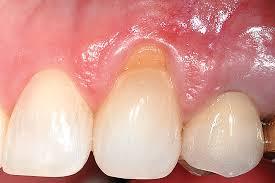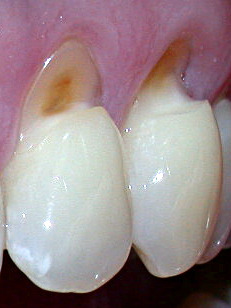Teeth Wearing Away at the Gum Line
Why are my teeth wearing away at the gum line?
That’s a surprisingly good question that we hear almost on a daily basis, and it’s surprisingly good because the dental community still hasn’t come to agreement as to the causative factor. Teeth begin to cup away at the gumline, often times causing recession and sensitivity. These are referred to as “Non-carious Cervical Lesions” or NCCLs. We are going to take this months article to explain the factors that may cause this phenomenon, how to limit further destruction, and how/when these defects should be restored.

The two possible causes of wear at the gumline are abrasion and abfraction. Abrasion is caused by overzealous brushing or using a stiff-bristle toothbrush. You may think that scrubbing your teeth gets them extra clean, but you could be damaging your teeth by using too much force. Gently brush your teeth with an extra soft toothbrush. With the right brushing technique, you’ll get your teeth just as clean without damaging them in the process. If you’re not sure whether you’re brushing effectively, come visit us and we will gladly show you some easy techniques.
The second cause of wear at the gumline is abfraction. Abfraction is caused by teeth improperly contacting one another. Teeth are built to handle up-and-down forces, like chewing. They are not designed to take side-to-side forces, which can weaken the tooth’s enamel. This weakening of the enamel leads to wearing down of the tooth at the gums. These side-to-side forces may occur through nighttime grinding of the teeth back and forth. It could also result from a tooth that is out of alignment.

Before your dentist fixes the damaged teeth, he must treat the cause of the wear. Otherwise, the problem will just return. If the wear was caused by brushing, the solution could be as simple as a gentler touch. If the wear was caused by misaligned teeth, it can be treated through small adjustments or orthodontics. If nighttime grinding is the cause, wearing a specially-designed mouthguard can solve the problem. It is important to note that a proper guard is more than just an old invisalign tray or soft sports guard. It is designed to orient forces correctly without causing jaw discomfort.
We restore these NCCLs if our patient is unsatisfied with how the teeth look, if the teeth are abnormally sensitive because of the lesion, or if the lesion is so severe that the integrity of the tooth is weakened.
If you notice these defects on your teeth or are getting a lot of sensitivity to cold/brushing, let your dentist take a look. Sometimes prevention is all that is needed, but left unchecked, major restorative work may be necessary.
